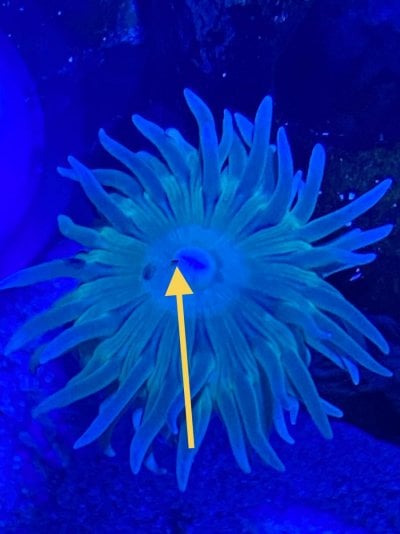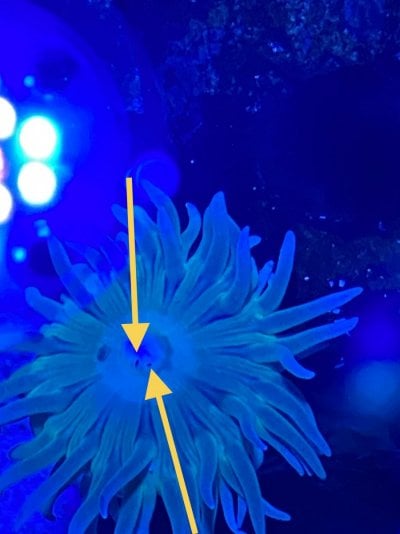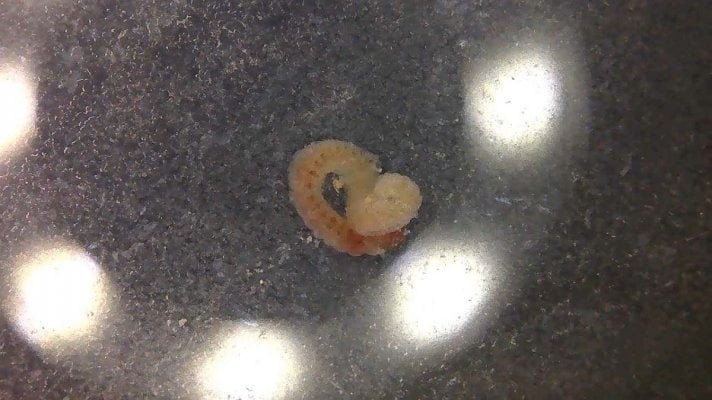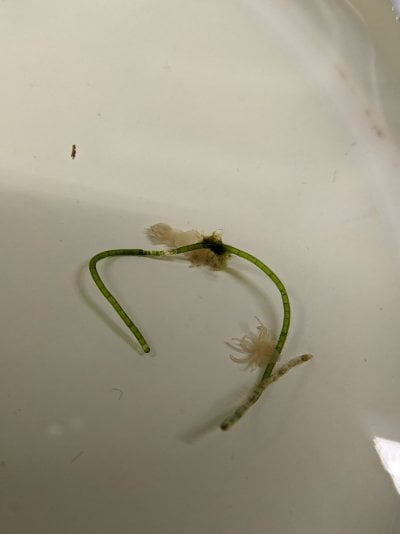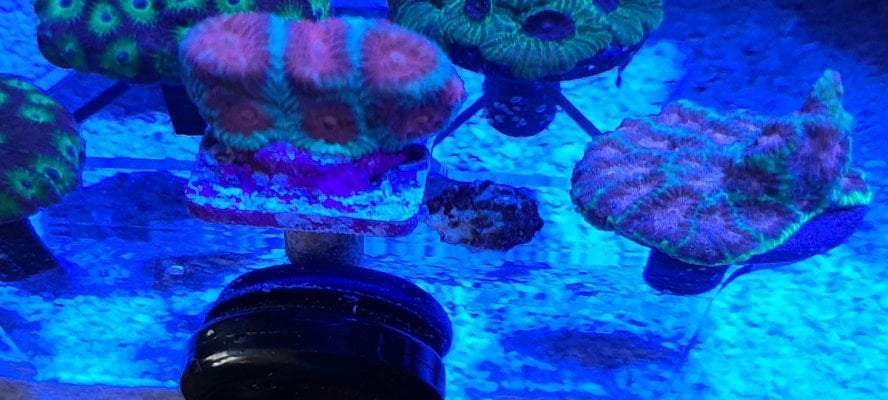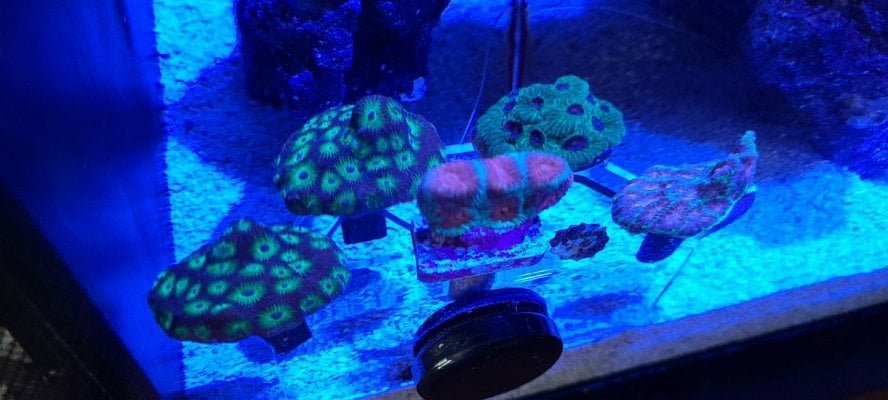Spionid worm harmless.I have some new frags under observation and one of them is a well encrusted efflo. I noticed some little v-shaped attena looking things coming out of three of the corallites. At first, I suspected vermetid snails, but I don't think that's what they are. No mucus net and seem a little more barnacle type.
Not sure what they are, and I'm trying to decide whether to excise them or leave them alone. Identification will help me decide the best course of action. I appreciate your help


Navigation
Install the app
How to install the app on iOS
Follow along with the video below to see how to install our site as a web app on your home screen.
Note: This feature may not be available in some browsers.
More options
You are using an out of date browser. It may not display this or other websites correctly.
You should upgrade or use an alternative browser.
You should upgrade or use an alternative browser.
What is that!! A R2R guide to common new tank hitchhikers.
- Thread starter Crabs McJones
- Start date
- Tagged users None
Planarian flatworm.
Eunice sp.This is the end of my tank? I've survived many issues only to get taken down by a hitchiker. I'd take out the rock, but he's not in one. It's in the sand bed. I'm assuming it's where my little watchman goby disappeared to. Sad.
Dorvillidae sp.Can I safely assume this is the larval state of the aptasia then? That is a 2" marine pure cube for scale.

Welcome to R2R!!!Anyone have an idea of what this is ? best quality i can get microscope is ******
Look like Feather duster without the tube.
Welcome to R2R!!!
Look like Feather duster without the tube.
Thanks for the reply , are they good?
Yes.Thanks for the reply , are they good?
I need some help with id. I decided to look at my tank with the lights off last night. It has been a few month since I did this. I have been suspect of a pest in my tank, but I’m not to sure what it is. They were mainly all over my soft corals and managed to find some on the glass too. They look like pods, but I’ve never seen pods do this or seen them this big.



Total noob here. Just got my first chaeto and have found three of these guys so far. Dreaded aiptasia, or something more fun?

Well, shucks. Here's a closer look for confirmation. I think I got them all..Look like Aiptasia to me!
Related: I was planning to put this in my FO tank while I finish my reef tank build. Plan is to use current FO tank as QT for new additions once the new tank is up. Bad idea to put this chaeto right in? Should I just keep it in its own QT until I'm confident I won't be seeding my QT with aiptasia?
Attachments
- Joined
- Jul 18, 2019
- Messages
- 52
- Reaction score
- 11
I am fairly new to reefing and have had many fw tanks. I found this little guy this morning amongst my favias. The red one next to the little guy was put in after drop acclimation and a Seachem coral dip two days ago. It looks like it has a sweeper tentacle out. Did i just have a baby favia? Any ideas. Showed up this morning when the lights came on.
Attachments
Never mind, did not have enough coffee this morning. It is some type of snail. I have a few Cerith snails but this is a new one. I have a couple of "live rocks" that had been in a friend's tank for 2-3 years. This one looks very old and all other snails accounted for. He went hiding again. I am learning many things every day thanks to R2R.I am fairly new to reefing and have had many fw tanks. I found this little guy this morning amongst my favias. The red one next to the little guy was put in after drop acclimation and a Seachem coral dip two days ago. It looks like it has a sweeper tentacle out. Did i just have a baby favia? Any ideas. Showed up this morning when the lights came on.
I think I’d just give up on life if I put my hand in the tank and that thing popped out. #deadThis is great for new people who are coming into the hobby. Bobbit Worms are scary
One of the greatest things about starting a reef tank is getting your live rock in and admiring all the diversity within it. The rock comes to life different creatures. This is a guide that I, along with a very well known critter identifier @KJ , have put together for the new reefer on what these hitchhikers are and whether they're a keeper or to pull them out.
Bristleworm -
Very common good hitchhiker. The jury is out on whether they're beneficial or not. Most consider them a vital part of your clean up crew. The hide within your live rock, coming out to pick up scraps of food and other detritus. Their numbers can become overwhelming based off how much food is available in the tank. If you overfeed, and they have access to an abundance of food, their numbers will increase dramatically. Be careful not to touch as the bristles on the sides of their bodies can be very irritating and cause an allergic reaction in some.
Fireworm -
Bad hitchhiker. Similar to the bristle worm, however if stung by the bristles on this little guy, its 10 times worse. DO NOT TOUCH UNDER ANY CIRCUMSTANCES! If found it is best to remove with a trap.
Pineapple Sponges -
Very common good hitchhiker. These little guys are a type of sponge. They are most commonly found in overflows and in high flow areas of the sump. However, they can sometimes bee seen in shaded areas of your rockwork.
Asterina Starfish -
Another common neutral hitchhiker. Jury is out on these guys as to good or bad. Some people love them, some hate them. They've been rumored to munch on coralline algae. They are also known to multiply very rapidly. Manual removal when seen is best to control their numbers.
Aiptasia -
Bad hitchhiker. This is a type of anemone that multiplies very quickly, and stings and kills anything that gets near it. Depended on how many you have, they're best removed by manually scraping them off the rock, and then using epoxy/superglue/kalk paste over where they were to prevent them coming back. A few predators that you can get for them include the peppermint shrimp, berghia nudibranch, and with a large enough tank, copperband butterflyfish.
Majano -
Bad Hitchhiker. This is another pest anemone that multiplies quickly and stings anything near it. Best removed by manual scraping off and super glue/epoxy/kalk past over its spot. Peppermint shrimp will reportedly consume them as well.
Vermedit Snail -
Very common neutral hitchhiker. They are generally harmless, but can multiply quickly based off nutrients in the tank, and can irritate corals. Manual removal or starving them out by putting a dab of superglue on the end of the tube is best to keep their numbers in check, as well as nutrient control.
Spirorbid Worm -
Very common neutral hitchhiker. These guys are most commonly found in overflows, and high flow areas of your sump. Can multiply very quickly and have been rumored to disrupt equipment such as pumps. Nutrient control keeps their numbers in check.
Ball Anemone -
Common neutral hitchhiker. They are found in shaded areas of live rock, and tend to not bother anything and numbers are kept in check with nutrient control. Are removed by the same means as the aiptasia and majano.
Stomatella Snail -
Very good hitchhiker. These guys are a great clean up crew member. They can be very elusive and most commonly found after lights out and are very fast moving. They feed off different algae in the tank.
Copepod/Isopod/Amphipod -



Very good hitchhikers. Often referred to as simply "pods" These little guys live within your rock work and make great food for your fish and corals. They can be the primary diet of certain mandarins.
Spaghetti Worm -
Good hitchhiker. Commonly found in the sand bed or live rock. They extend out multiple tentacles to catch floating detritus. Good member of your clean up crew.
Hydroids -

Bad hitchhikers. Good news is that they don't tend to live very long and die off on their own as the tank progresses.
Sponges -
Good hitchhiker. Very common filter feeders. Found in shaded areas of live rock
Serpent And Brittle Starfish -

Good hitchhikers. Are most commonly found by the arms extending out from cracks and holes in rock work. Feed off leftover food and detritus in the tank.
Bobbit Worm -
Very bad hitchhiker. These guys can grow to be very large and can kill fish. Most common means of removal is to remove the entire rock where the worm is housed. Be careful of the pincer teeth at the head of the worm.
Tunicate -
Good hitchhiker. Harmless filter feeder. At first glance looks like a sponge, except it pulses as it takes in and expels water, and reacts to touching it.
Limpet -
Good hitchhiker. Consumes algae. Don't seem to bother anything.
Chiton -
Good hitchhiker. Consumes algae. Does not appear to bother anything.
Peanut Worm -
Good hitchhiker. Lives in live rock and feeds off of extra food and detritus.
Gorilla Crab -
Bad hitchhiker. Can be found in live rock cracks, caves and holes. They are predatory and will hunt your shrimp and inverts. They can also grow rather large.
Benthic Ctenophores -
Been seeing this one pop up more and more lately, so I figured why not add them to the list.
They are a neutral hitchhiker. They mainly filter feed on zooplankton and small particulates in the water. Most commonly referred to as comb jellys.
Red Planaria Flatworm -
Bad Hitchiker. While they don't consume any coral, they can grow in numbers to the point where they smother coral. Caution should be taken as when these die off they release toxins that can wipe out a tank quickly.
Ghost Flatworm -
Neutral hitchiker. Doesn't harm anything. But does consume pods
Acoel Flatworm -
Neutral Hitchiker. Doesn't harm anything, however can grow greatly in numbers quickly
Polyclad Flatworm -
Bad Hitchhiker. Predatory towards clams and coral depended on subspecies.
Pumpkin Flatworm (Waminoa Sp)
Bad Hitchiker. Predatory. Can smother and kill LPS corals.
Acropora Eating Flatworm -
Bad Hitchiker. See name
I did not cover Nudibranch or snails in this thread as there are far to many variations to cover. If you have an unknown, please create a thread or post it in this thread and we'll try our best to ID it for you. If you have any additions to the list please PM me and I'll review it and add to the list.
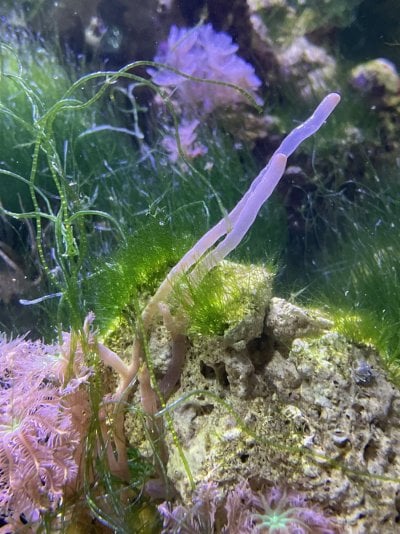
Similar threads
- Replies
- 2
- Views
- 80
- Replies
- 2
- Views
- 169
- Replies
- 13
- Views
- 241
- Replies
- 9
- Views
- 285




![20210301_105149[1].jpg 20210301_105149[1].jpg](https://test.reef2reef.com/data/attachments/1984/1984377-354a78b8a11bf1920fc646d0babcc6ca.jpg)

